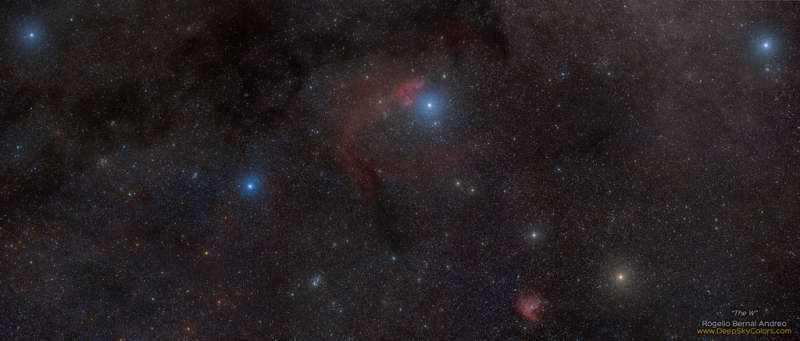Credit & Copyright: Rogelio Bernal
Andreo (Deep Sky Colors)
Explanation:
A familiar, zigzag, W pattern in northern
constellation Cassiopeia
is traced by five bright stars in this colorful and broad mosaic.
Stretching about 15 degrees across rich starfields,
the celestial scene
includes
dark clouds,
bright nebulae, and
star clusters along the Milky Way.
In yellow-orange hues Cassiopeia's
alpha star
Shedar is a standout though.
The yellowish giant star is cooler than the Sun, over 40 times the
solar diameter, and so luminous it shines brightly in
Earth's night from 230 light-years away.
A massive, rapidly rotating star at the center of the W, bright
Gamma Cas
is about 550 light-years distant.
Bluish Gamma Cas is much hotter than the Sun.
Its intense, invisible ultraviolet radiation ionizes hydrogen atoms in
nearby interstellar clouds to produce
visible red H-alpha emission as the atoms recombine with electrons.
Of course, night skygazers
in the Alpha Centauri star system
would also see the recognizable outline traced by
Cassiopeia's bright stars.
But from their
perspective a mere 4.3 light-years away they would see
our Sun as a sixth bright star in Cassiopeia, extending the zigzag
pattern just beyond the left edge of this frame.
1999 2000 2001 2002 2003 2004 2005 2006 2007 2008 2009 2010 2011 2012 2013 2014 2015 2016 2017 2018 2019 2020 2021 2022 2023 2024 2025 |
Yanvar' Fevral' Mart Aprel' Mai Iyun' Iyul' Avgust Sentyabr' Oktyabr' Noyabr' Dekabr' |
NASA Web Site Statements, Warnings, and Disclaimers
NASA Official: Jay Norris. Specific rights apply.
A service of: LHEA at NASA / GSFC
& Michigan Tech. U.
|
Publikacii s klyuchevymi slovami:
Kassiopeya - zvezdy - zvezdnoe nebo
Publikacii so slovami: Kassiopeya - zvezdy - zvezdnoe nebo | |
Sm. takzhe:
Vse publikacii na tu zhe temu >> | |
